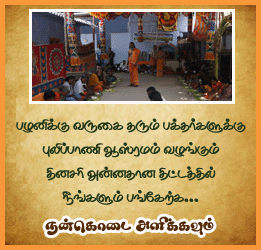
| FOLLOW US ON: | |||||||

HOME > Program/Classes > Yogasanam > Type of Asana
INTRODUCTION
Yogic postures or asanas are one of the most important systems of physical culture ever invented. They reflect an amazing understanding of how the body works and particularly, how to release tension at a deep level from the tissues, organs and joints.
ABJECTIVE OF ASANAS
Asana is the main yogic tool for balancing the physical body. It consists of various static postures and physical movements performed to release tension, improve flexibility, maximize the flow of energy, and remove friction. The objective of asana is to create a free flow of energy, and remove friction. The objective of asana is to create a free flow of energy in order to help direct our attention within. But this flow of energy can also focus on the body to treat its ailments.
Our physical posture affects our health, vitality and awareness. The mind-body complex consists of various interrelated channels-from those, which carry food to those, which carry thoughts. These channels are held together on a physical level by the muscular skeletal system, the shape of which is determined by our posture.
Wrong posture creates various stresses, causing contractions that impair or block the proper flow of prana through the channels. It inhibits the circulation of energy and nutrients while allowing toxins and waste materials to accumulate. Such blockages cause discomfort and reduce functioning, resulting in pain and disease. As mind and body are interconnected, physical blockages intertwine with mental and emotional blockage and hold various obsession, compulsions and attachments.
PHYSICAL LEVEL
The physical body (Annamaya Kosha) is centre in the digestive track. If our posture is wrong then movement through the digestive tract gets obstructed. This disturbs or lowers the functioning of Agini, the digestive fire, which in turn, weakens or deranges digestion, leading to various ailments. Tightness in the upper back and chest weakens the appetite, which is determined by the prana in the head and month. Tightness in the middle back and mid-abdomen weakens the digestive fire in the small intestine, which can become squashed by accumulated tension, causing malabsorption of food. Tightness or weakness in the lower back and abdomen constricts and weakens the colon. This creates gas and distension and upsets elimination, resulting in constipation or diarrhea and other digestive problem.
PRANIC LEVEL: The pranic body (Pranamaya Kosha) works mainly through the respiratory and circulatory systems of the physical body. Oxygen is carried through the blood to energize all the tissues. If our posture is wrong then the lungs get impaired in their function. The Breath becomes shallow and oxygen absorption is reduced. Mucus and stagnant air build up air-borne pathogens is lowered along with poor immune function. Naturally, the posture of the upper and middle back strongly affects the lungs and circulation.
TYPES OF ASANAS
Asanas are many in nature some are easy and some are difficult. The value of asana does not depend upon it being easy or difficult. But on its systematic and regular practice.
Classification on the Basis of Starting Position:
Different schools of yoga classified asana in different types. One method of classification is on the basis of the starting position of the asanas. This is the major type of classification. Thus the asanas are classified into four types
1. Standing asanas
Position: Stand in normal position with the heels joined together, the toes apart. Keep the hands close to the body.
Every man needs the balancing power in his body. In order to increase or to develop the existing balancing power in the body, asanas can be practiced from a standing position. The following asanas can be practiced from standing position.
- Tadasana
- Vrikshasana
- Trikonasana
2. Sitting Asanas
Position: Sit on the floor with legs extended forward. The toes and heels are pointed together. The body should be kept erect. Hands should be placed on the floor by the side of the buttocks.
Yogic practices are mainly concerned about the control of the body and the mind. Asanas play a vital role to achieve this purpose. Sitting asanas are intended for bringing the mind to a relaxed state. The meditative postures are all done from this position. These asanas not only develop the mental health but also stimulate the physiological functions of our body systems.
The asanas included in the sitting position have all possible movements of the vertical column like erect, forward bend, backward bend and twisting postures.
The following asanas can be practiced from sitting position:
- Padmasana
- Sukhasana
- Paschimottanasana
- Ardha matsyendrasana
3. Prone Asanas (Abdominal)
Position: Lie on the prone with face downward. Keep the legs straight; joint the heels and toes together. Place the hands above the body with palms facing downwards. The asanas included in the prone position mainly emphasis the backward bend at the vertical column. One who practices these asanas should keep it in mind that the supine asanas be followed to get the proper opposite movements and balance to the spine. In prone position also, number asanas are available for practice. The selected asanas provides all possible and necessary movements for an individual in this position.
The following asanas can be practiced from prone position:
- Makrasana
- Salabasana
- Bhujangasana
- Dhanurasana
4. Supine Asanas
Position: Lie on the floor with face facing upward. Keep leg straight, heels and toes should be joined together. Hands should be placed above the head, with palm facing upward. Many asanas are there to perform from the supine position. They provide essential movements on the various joints in the body particularly for the vertebral column. These asanas also provide sufficient amount of workouts to the vital internal organs as well as to the endocrine system.
The following asanas can be practiced from supine position:
- Savasana
- Sarvangasana
- Halasana
Classification on the basis of movements and final pose, Some schools of yoga classified on the basis of the movements and final pose of the asana. Thus the asanas are classified into three types:
- Meditation
- Relaxation Asanas and
- Cultural Asanas
ADVANCED ASANAS
The advanced asana should not be attempted unless the body is very flexible. The asanas in the basic category must be mastered before trying to perform any of these postures. While practicing the advanced asanas it is essential to avoid over straining the body in any way. These practices require the limbs and joints to move into unusual positions to which they are not habituated. Any strain may damage them. Gently coaxing the body to perform advanced asanas over a period of time is far better than trying to achieve quick results through force.
The advanced asanas require a greater degree of steadiness, concentration and coordination with the breath. These asanas are intended for people with extensive control over their muscles and nervous systems. Practitioner should not be too eager to start these asanas. It is preferable to practice them under the guidance of the yoga teacher.
Some of the advanced asanas are:-
1.Poorna Dhanurasana
2.Ardha badha padma paschimothanasana
3.Parvritta Janu Sirshasana
4.Sarvangasana
 |
 |
 |
 |
| SWAMY JEE INFO | SWAMY JEE PROGRAMS | KUNDALINI THEKSHA - SWAMY JEE | ASHRAM ADDRESS |
©
2012.Ssrimath Bhogar
|
||
| About Swamy Jee | Yoga Classes |  |
SRIMATH BHOGAR PALANI ATHEENAM, Pulippani Ashram, Adivaram. Palani - 624601. South India. Phone: +91 99942 16408, 78110 01166 E-mail: contact@siddharpulippanitradition.org |
|||
| Swamy Jee Books | Meditation Classes | |||||
| Swamy Jee TV interview | Spritual Camp | |||||
| Swamy Jee Video Gallery | Online Homam | |||||
| Swamy Jee Photo Gallery | Online Poojas | |||||


